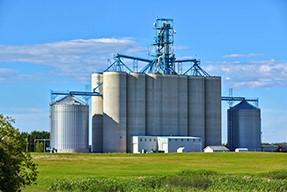Off-farm grain storage at elevators offers much more capacity than on-farm bins, and U.S farmers with large production volume often sell their grain at harvest to these facilities. According to the U.S. Department of Agriculture (USDA), the United States’ off-farm commercial storage capacity is 272 million metric tons (10.7 billion bushels).
Large commercial storage facilities receive grain from multiple sources with a varied degree of moisture and quality conditions. The facilities blend grain sources together with the end goal of producing a consistent quality product that will meet contract specifications for international customers.
Maintaining quality throughout storage to the point of export requires planning and management to avoid potential problems and to meet customer expectations.
“Proper facility design based on volume is essential to managing grain quality in large commercial facilities throughout the storage period,� said Carol Jones, Ph.D., a grain storage expert at Oklahoma State University.
Grain temperature is a key factor to monitor and control in grain storage. Proper training is essential to understand different grain properties, appropriate monitoring techniques, and specific grain quality management, such as correct pressure during aeration. Many state extension services, in partnership with land-grant universities, offer such training for grain elevator employees.
Another consideration farmers, elevator operators and personnel consider is that increased handling can lead to increased breakage and thus a lower quality grain.
“Some grain lots handle better than others based on growing and storage management conditions,� Jones said. “Regardless, following guidelines to minimize breakage is key.�
Effective grain management can prevent conditions that lead to insects and mold in the stored product. The factors affecting these problems in stored grain are moisture content, grain temperature, the length of time grain is susceptible to adverse conditions and storage accessibility to pests.
“There is no scientific evidence that insects found in stored grain come from the field with harvested grain,� Jones said. “Therefore, sanitation along with proper aeration to cooler outdoor temperatures during the autumn season is essential to suppress infestation.�
Although specific chemical treatments are approved for application directly to grain for insect control, some customers don’t allow them in their purchase contracts. To make grain available for these contracts, experts recommend extra sanitation efforts to minimize pest access.
Ultimately, the intended use of grain dictates the quality of the grain specified in a buyer’s contract. Off-farm commercial storage facilities employ multiple management techniques and strive to provide a consistent quality product for the variety of grains available from U.S. farmers to international buyers.
“Some grain lots handle better based on growing and storage management conditions. Regardless, following guidelines to minimize breakage is key.� – Carol Jones, Ph.D.


